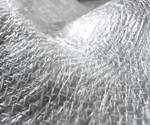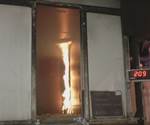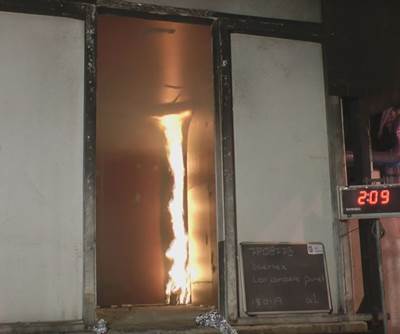TRB develops fire-resistant biocomposite door leaf
The carbon fiber-reinforced biocomposite sandwich panel features a 100% recycled foam core and has been designed for light weight and fire resistance.
TRB Lightweight Structures Ltd. (TRB; Cambridgeshire, U.K.) has developed a new carbon fiber-reinforced biocomposite sandwich panel door leaf with a 100% recycled foam core, specifically designed and fire rated for both overground and underground rail use.
The composite structural system is said to easily pass BS 6853 and BS 476 standards and is EN 45545 HL3 compliant. The product, TRB says, offers a sustainable, “green” composite material option for carriage door leaves at a comparable cost to aluminum bonded door leaves, with a 35% weight saving.
The design and engineering team at TRB has worked closely with a resin partner to develop a new, proprietary carbon fiber-compatible, bio-based prepreg resin. TRB says that the new system had to be highly sustainable, cost-effective to manufacture and lightweight while meeting demanding fire, smoke and toxic fumes (FST) specifications in subterranean rail applications. The new “bio” prepreg, which is non-toxic and does not use volatile organic solvents, is based on a Polyfurfuryl alcohol (PFA) resin derived from a renewable alcohol produced from a natural waste byproduct from refined sugar production.
The biocomposite prepreg system can also be used for other rolling stock parts, TRB says. The foam core used in the rail door leaf composite structure is produced from 100% recycled consumer plastic. It was selected by TRB as the recycled foam core to meet the goal for sustainability, and it delivers the desired overall material properties performance of the sandwich panel construction when used in combination with the woven carbon fiber fabric on both sides and the bio resin prepreg. Other matrix design options for other applications using glass fibers, natural fibers or aramid fibers can be custom made on request, TRB says. Depending on rail customer needs, door leaves are supplied with a gelcoat, finish painted or primed ready to paint.
According to the company, during BS 476 Part 7 testing, the sandwich panel system achieved a Class 1 category 1a rating, with a 30% less recorded flame spread of 50 millimeters in the 1.5 minute test time, compared to the maximum allowable of 165 millimeters for the Class 1a rating. “We are extremely pleased with the overall performance data for the new biocomposite carbon fiber prepreg sandwich panel system, in particular the FST specifications achieved,” says Lyndon Newman, chief engineer for TRB. “In the 30 years I have been in the industry, I have never seen such impressive fire performance test results for a non-phenolic based thermoset system, achieving the BS standard so comfortably. Our PFA bio resin prepreg has fire retardant properties greater than phenolics, plus excellent temperature and chemical resistance.”
Read more about the fire resistance of TRB’s prepreg and other fire-resistant composite materials in “Withstanding fire without the weight”
“We initially developed this biocomposite product for rail door leaves, but it could be used for other mass transport interior applications. We have brought aerospace prepreg technology to our rail customers,” Newman adds.
The door leaf product is said to weigh 26 kilograms, a 35% reduction in weight compared to a 40-kilogram aluminum equivalent. The TRB door leaf is reported to have a 40-year life cycle expectancy, and compared to aluminum, its benefits are said to include more robustness, superior fatigue resistance, low maintenance costs, reduced energy consumption per journey, less track wear and tear, and other cost- and weight-saving benefits.
Related Content
Low-cost, efficient CFRP anisogrid lattice structures
CIRA uses patented parallel winding, dry fiber, silicone tooling and resin infusion to cut labor for lightweight, heavily loaded space applications.
Read MoreAn outlook on China’s carbon fiber market
This analysis sheds additional light on the insights, observations and data shared in ATA Industrial Group’s carbon fiber market report on global and Chinese industry players.
Read MorePrepreg compression molding supports higher-rate propeller manufacturing
To meet increasing UAV market demands, Mejzlik Propellers has added a higher-rate compression molding line to its custom CFRP propeller capabilities.
Read MorePlant tour: Teijin Carbon America Inc., Greenwood, S.C., U.S.
In 2018, Teijin broke ground on a facility that is reportedly the largest capacity carbon fiber line currently in existence. The line has been fully functional for nearly two years and has plenty of room for expansion.
Read MoreRead Next
Withstanding fire without the weight
New composites meet stringent fire requirements while lightweighting ships, rail cars and battery boxes for electric cars and planes.
Read MoreMeasuring and improving fire resistance in composites
Sidebar to CW’s Feb 2019 feature article, this quick review of fire tests for composites also provides more details about intriguing new material developments.
Read MoreCeramic matrix composites: Faster, cheaper, higher temperature
New players proliferate, increasing CMC materials and manufacturing capacity, novel processes and automation to meet demand for higher part volumes and performance.
Read More
.jpg;width=70;height=70;mode=crop)

























